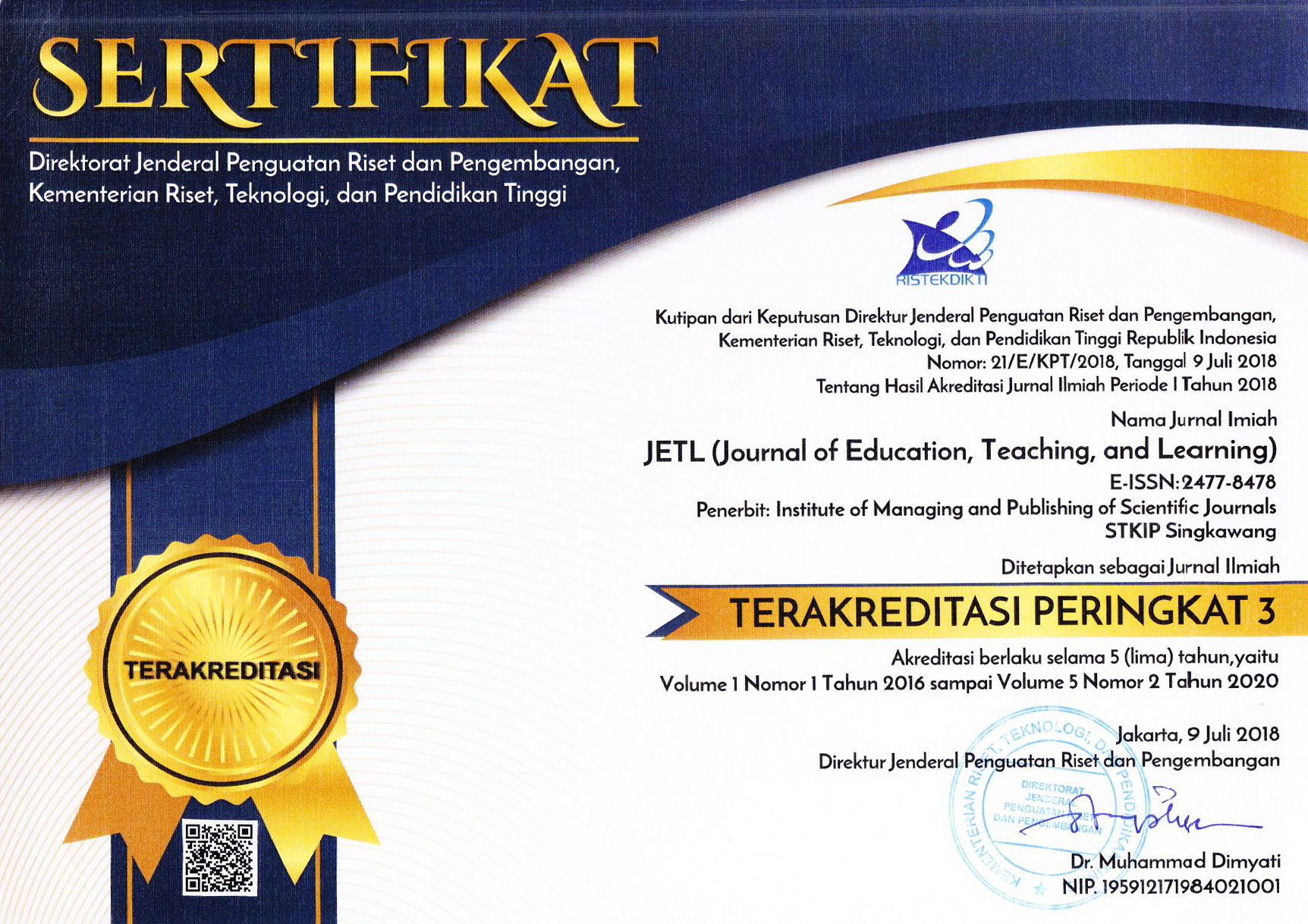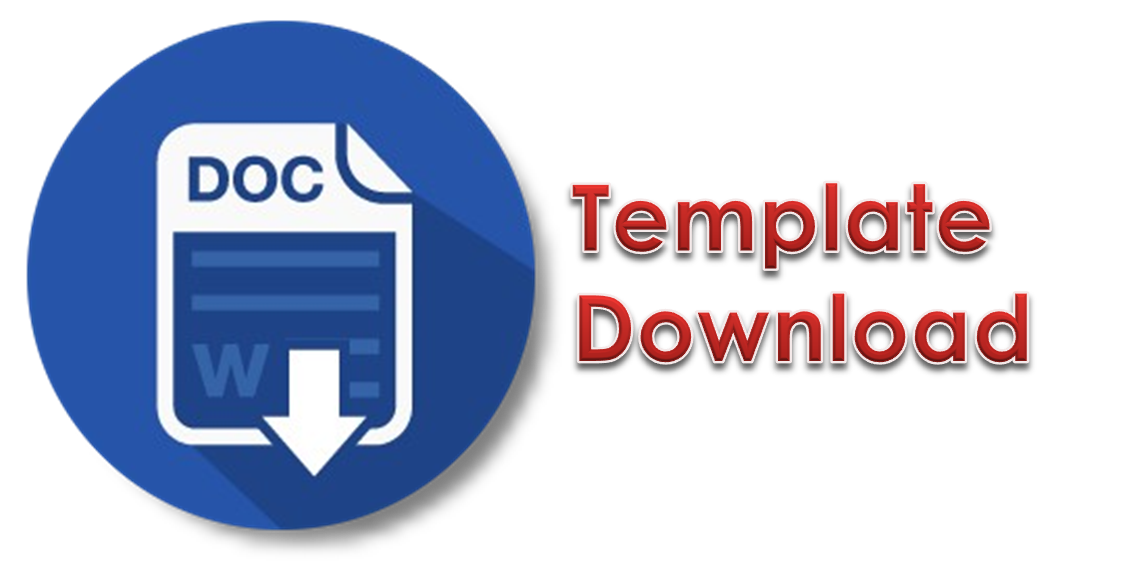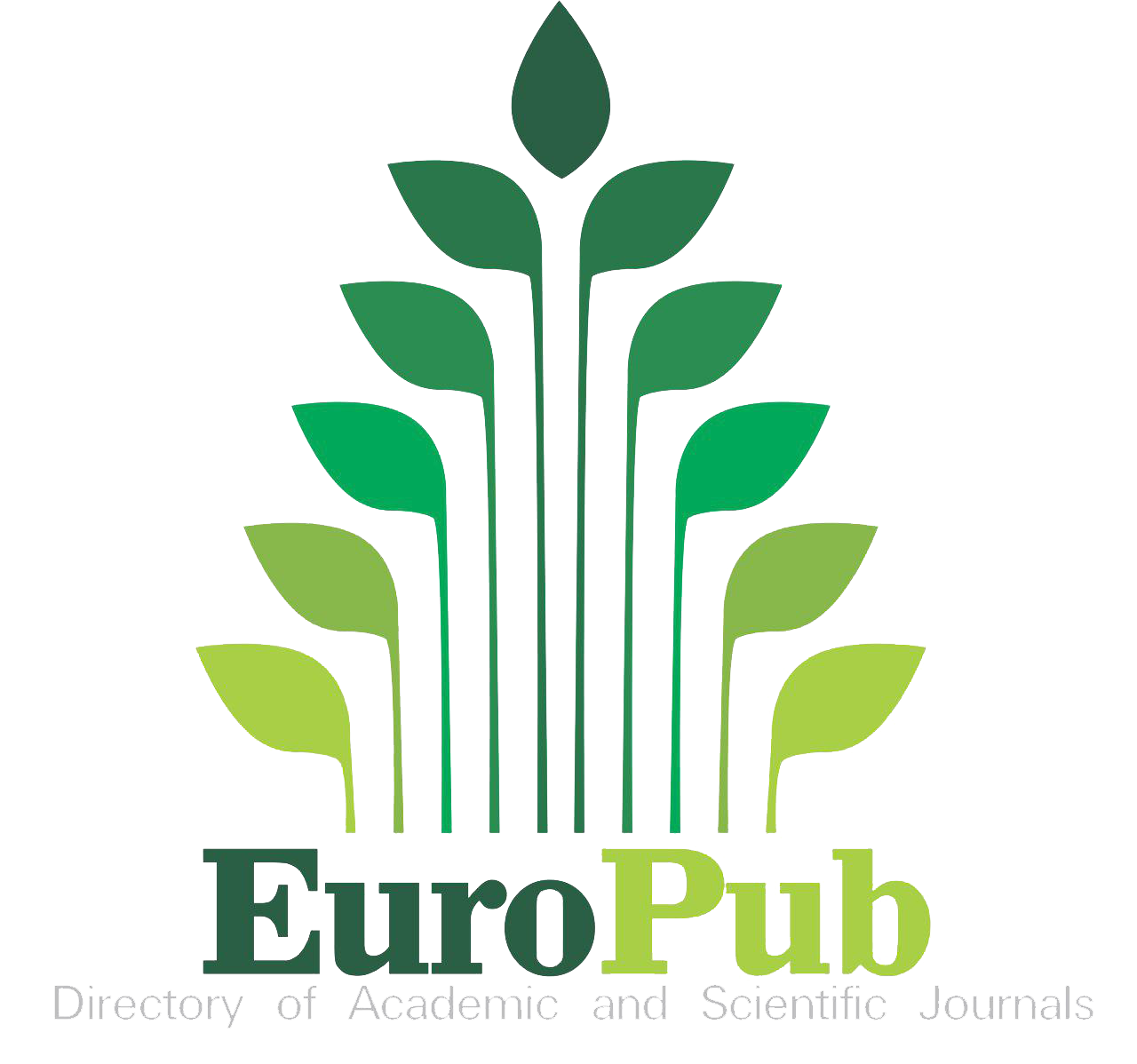Students Water Literacy in South Sumatera Indonesia, Does Indigenous Culture Had Influence?
Abstract
Keywords
Full Text:
PDFReferences
Ajzen, I. 1991. The theory of planned behavior. Organizational Behavior And Human Decision Processes. Vol 50. No.2: 179-211.
Bistari, B. 2017. The Local Wisdom of Sambas Malay Ethnic Assessed from Character Mathematical Connections. Journal of Education, Teaching and Learning, 2(2), 147-150.
Castelló, Amparo& Rafael Doménech. 2002. Human capital inequality and economic growth: some new evidence. The Economic Journal. No. 112: 187-200
Covitt, B. A., Gunckel, K. L., & Anderson, C. W. 2009. Students' developing understanding of water in environmental systems. The Journal of Environmental Education. Vol. 40. No. 3 : 37-51.
Darmadi, H. 2018. Sumpit (blowgun) as traditional weapons with Dayak high protection. Journal of Education, Teaching and Learning, 3(1), 113-120.
Dean, A. J., Fielding, K. S., & Newton, F. J. 2016. Community knowledge about water: who has better knowledge and is this associated with water-related behaviors and support for water-related policies?.PloS ONE, Vol. 11. No. 7): e0159063.
Denzin, N. K., Lincoln, Y. S., & Smith, L. T. (Eds.). 2008. Handbook of critical and indigenous methodologies. Sage.
DeVellis, R. F. 2016. Scale Development: Theory And Applications. Sage publications. California USA. Volume 26
Febriani, A. 2017. Water Literacy in Developing Country-A case study for Indonesia. Master’s Degree, Lund University, Lund Sweden Fielding,
Folke, C. 2004. Traditional knowledge in social–ecological systems. Ecology And Society, Vol. 9. No. 3.
Graveline, F. J. 2002. Teaching tradition teaches us. Canadian Journal of Native Education, Vol. 26. No. 1: 11.
Harlan, S.L., Yabiku, S.T., Larsen, L. and Brazel, A.J., 2009. Household water consumption in an arid city: affluence, affordance, and attitudes. Society and Natural Resources. 22 no. 8: 691-709.
He, H. S. 2018. Construction of the index system of water literacy and application in a case study of four Chinese communities. Journal of Discrete Mathematical Sciences and Cryptography. Vol. 21. No. 2 : 485-491.
Johnson, D. R., & Courter, J. R. 2020. Assessing water literacy at a primarily undergraduate university in Ohio. Natural Sciences Education, Vol. 49. No.1: e20024.
Karnadewi, F., Mitchell, E., & Newton. F.A. 2015. National Survey of Australians' Water Literacy and Water-related Attitudes. https://research.monash.edu/en/publications/a-national-survey-of australians-water-literacy-and-water-related. Access date 24 Agustus 2020
Kovach, M. 2010. Conversation method in Indigenous research. First Peoples Child & Family Review: An Interdisciplinary Journal Honouring the Voices, Perspectives, and Knowledges of First Peoples through Research, Critical Analyses, Stories, Standpoints and Media Reviews, Vol. 5. No.1: 40-48.
Levêque, J. G., & Burns, R. C. 2018. Drinking water in West Virginia (USA): tap water or bottled water–what is the right choice for college students?. Journal of Water And Health, Vol. 16. No. 5: 827-838.
Ma, G. 2015. Food, eating behavior, and culture in Chinese societ. Journal of Ethnic Foods. Vol. 2. No. 4: 195-199.
Maréchaux, I., Bartlett, M.K., Sack, L., Baraloto, C., Engel, J., Joetzjer, E. and Chave, J. 2015. Drought tolerance as predicted by leaf water potential at turgor loss point varies strongly across species within an Amazonian forest. Functional Ecology. 29 no. 10: 1268-1277.
Martens, L., Southerton, D., & Scott, S. 2004. Bringing children (and parents) into the sociology of consumption: Towards a theoretical and empirical agenda. Journal of Consumer Culture. Vol 4, No. 2 : 155-182.
Martin, D. E. Suharjito, D. Darusman, S. Sunito; &Winarno, B. 2016. Traditional Institution for Forest Conservation within a Changing Community: Insight from the Case of Upland South Sumatra”, Komunitas: International Journal of Indonesian Society and Culture .Vol.8, No.2, pp 236-249.
Martin, E. D. Suharjito, D. Darusman, S. Sunito, and B. Winarno. 2016. TungguTubang and UluAyek: Social Mechanism of Sustainable Protected Forest Management, Jurnal Manajemen Hutan Tropika. Vol. 22, no. 2, pp 85-93.
Masuku, L. S. 1999. The role of indigenous knowledge in/for environmental education: The case of a Nguni story in the Schools Water Action Project, Doctoral dissertation, Rhodes University.
Mawardi, I. 2010. Kerusakan daerah aliran sungai dan penurunan daya dukung sumber daya air di pulau jawa serta upaya penanganannya. Jurnal Hidrosfir Indonesia 5. no. 2
McGuinness, S. L., O’Toole, J., Barker, S. F., Forbes, A. B., Boving, T. B., Giriyan, A., ... &Leder, K. 2020. Household Water Storage Management, Hygiene Practices, and Associated Drinking Water Quality in Rural India. Environmental Science & Technology, Vol. 54. No.8: 4963-4973.
Meilinda, Khoiron Nazip, and Riyanto. 2021. Indigenous Knowledge of Besemah-Semende‘s People on Water Conservation Resources. International Journal of Environmental Science and Development vol. 12, no. 3, pp. 87-94, 2021.
Onukogu, S. C.; Ugwuanyi, P. N.; &Adiaha, M. S. 2018. Level of awareness, perception and attitude of senior secondary school students towards water in Chanchanga Local Government Area, Niger state. World Scientific News. Vol. 105 : 74-98.
Opoku, K. 2006. Forest Governance in Ghana: An NGO Perspective. FERN, The Netherlands.
Otaki, Y., Sakura, O., & Otaki, M. 2015. Advocating water literacy. Mahasarakham International Journal of Engineering Technology. Vol. 1, No.1: 36-40.
Owen-Smith, N. 2009. Introduction To Modeling In Wildlife And Resource Conservation. John Wiley & Sons. New York.
Peat, F.D. 1994. Lighting the seventh fire: The spiritual ways of healing and science of the Native American. New York: Birch Lane Press
Qian, N. 2018. Bottled water or tap water? A comparative study of drinking water choices on university campuses. Water, Vol. 10. No.1: 59.
Royyani, Hastri. 2017. Climate Change Impacts, Clean Water Crisis in Indonesia. https://www.itb.ac.id/news/3177.xhtml. Access date 3 September 2020.
Scroggie, A., &Dargay, A. T. 2009. Presentations on Storytelling from National Storytelling Conference in Bhutan.
Spaargaren, G. 2004. Sustainable consumption: a theoretical and environmental policy perspective, in Southerton, D., H. Chappells and B. Van Vliet (Eds) Sustainable Consumption: The implications of changing infrastructures of provision, Cheltenham: Edward Elgar. pp.15-31
Sreen, N., Purbey, S., &Sadarangani, P. 2018. Impact of culture, behavior and gender on green purchase intention. Journal of Retailing and Consumer Services. Vol. 41: 177-189.
Stables, A. & Bishop, K. 2001. Weak and strong conceptions of environmental literacy: implications for environmental education, Environnzental Education Research. Vol. 7, pp. 00-00.
Suryani, A. S. PersepsiMasyarakatdalamPemanfaatan Air Bersih (StudiKasusMasyarakatPinggir Sungai di Palembang). 2016. Jurnal Aspirasi. Vol. 7. No.1: 33- 48.
Towell, C., 2009. The Survival Handbook: Essential Skills for Outdoor Adventure. DK Pub. Vickers, A., 2001, ‘’Handbook of Water Use and Conservation’, Waterplow Press, Amherst, MA,
Wood, G. V. 2014. Water literacy and citizenship: education for sustainable domestic water use in the East Midlands. Doctoral dissertation, University of Nottingham, Nottingham UK.
Wutich, A., Rosinger, A. Y., Stoler, J., Jepson, W., & Brewis, A. 2020. Measuring human water needs. American Journal of Human Biology . Vol. 32. No. 1: e23350./span> 39. 447.
Yenrizal, R. Agus, B. Atwar, and I. Johan. 2015. Makna simbolik sawah di masyarakat pedesaan tinjauan komuniasi lingkungan pada masyarakat Semende Darat Tengah Kabupaten Muara Enim-Sumatera Selatan, Jurnal Kawistara. Vol 5. No. 3, pp 2216-138.
DOI: http://dx.doi.org/10.26737/jetl.v8i1.3697
Refbacks
- There are currently no refbacks.

This work is licensed under a Creative Commons Attribution-NonCommercial 4.0 International License.
Published by:
Institute of Managing and Publishing of Scientific Journals STKIP Singkawang
Sekolah Tinggi Keguruan dan Ilmu Pendidikan (STKIP) Singkawang
Address : STKIP Singkawang, Jalan STKIP - Kelurahan Naram Singkawang, Kalimantan Barat, INDONESIA, 79251
No. Telp. : +62562 420 0344
No. Fax. : +62562 420 0584
JETL (Journal of Education, Teaching, and Learning)
e-ISSN : 2477-8478
p-ISSN : 2477-5924

Editor in Chief Contact: [email protected] / Wa: +6282142072788
Publisher Contact: [email protected] / Wa: +6282142072788
Management Tools
JETL Indexed by:
JETL (Journal of Education, Teaching, and Learning) is licensed under a Creative Commons Attribution-NonCommercial 4.0 International License.











